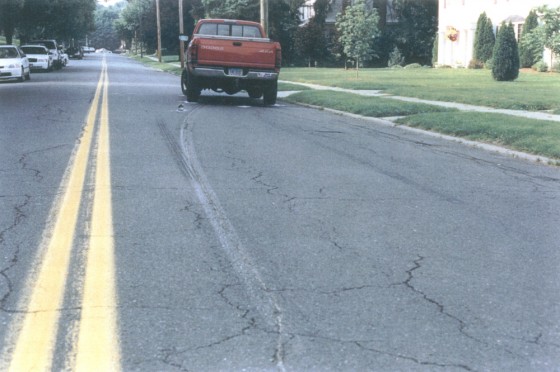Accident reconstructionists are often called on to determine the distance that a car, covers while being braked to a stop. Conversely, the reconstructionist may be given information as to the length of the skidmarks left by a car on the roadway, and may be asked to determine how fast the car must have been going at the beginning of the skid. An expert can accomplish this with considerable accuracy, based on a knowledge of the physical principles that are involved, plus available information relating to the friction of tires on various types of road surfaces.

There are two physical principles involved. The first relates to the energy that a car (or any other object) has due to its speed. (The engineer calls this kinetic energy, but we may refer to it as energy of motion.) This energy depends on the weight of the car (including its occupants and anything else which it may be carrying), and on the square of its speed. Thus, if two cars are going at the same speed but one weighs twice as much as the other, it has twice the energy of motion; but if the two cars weigh the same, but one is going twice as fast as the other, it has four times the energy of motion.

The second principle involves the energy expended in the rubbing or sliding of the tires along the roadway (on the assumption that full braking is applied, so that the wheels are locked and do not rotate). This frictional energy depends (like energy of motion] on the weight of the car, and the distance covered during braking. Further, it depends on the coefficient of friction or friction factor of the tires against the roadway. Fortunately, the friction factor has been found to be pretty much the same for all conventional tires and all degrees of tire wear (at least under dry conditions), although it varies appreciably with the quality of the roadway. For example, good-quality clean concrete or asphalt can yield a friction factor as high as 0.75, which means that for a car weighing 2000 pounds the force exerted by the locked tires against the roadway is 0.75 times 2000 or 1500 pounds. While the tires are pushing against the roadway with this force, it must be conceived that the roadway is pushing backward with exactly the same force, and it is this backward force which brings the car to a stop. For worn and polished road surfaces, perhaps with a covering of dirt and possibly some grease, the friction factor may drop to 0.5 or even less, especially at higher speeds.
As the vehicle skids during full braking, the rubbing of the tires uses up energy, this energy being supplied by the vehicle’s energy of motion, which accordingly diminishes until it is reduced to zero, thus bringing the vehicle to a stop.
The engineer or scientist writes the expression for the energy of motion, and equates it to the mathematical expression for frictional energy of the tires. Since the weight of the vehicle appears in the same way on both sides of the resulting equation, it cancels out and therefore does not have to be considered at all. He must, however, make the best estimate possible of the value of the friction factor, based on his knowledge of the quality of the roadway and, to a lesser extent, on whether the speed is high, medium or low. Then he can solve the equation to determine the actual value of the speed (at the beginning of braking) if the braking distance is known (through tire marks or otherwise), or to determine the braking distance if the initial speed is known or can be reasonably estimated.
The above applies only in the case of full braking, with locked wheels. If less than full braking is applied, there is no straightforward way of relating the speed to the braking distance—except for cars which have an automatic anti-skid system which limits the braking force so that the wheels do not quite lock (which yields a shorter braking distance for a given speed).
We next briefly comment on the case where full braking is applied, but the vehicle is stopped by impact with another vehicle or other obstruction before braking is completed. The physical principles described above can be used by the engineer to determine the relationship between speed before braking and speed just prior to impact, but a complete analysis for such cases can be made only if the deformation of the vehicle, caused by the impact, is taken into account.